Worldwide clinical trials may greatly improve and enhance management of Hodgkin lymphoma, according to a recent article published in Clinical Medicine Insights: Oncology. Thomas J. FitzGerald, MD, and Maryann Bishop-Jodoin, MEd, analyzed the differences between Hodgkin lymphoma treatment in Europe with that in North America and found a significant variation in how patients with Hodgkin lymphoma are assigned into categories. But therapeutic approaches for patients with early and intermediate-risk features who demonstrate a strong response to initial chemotherapy are aligned.
THE STUDY
Management strategies are influenced by the patient’s age at time of diagnosis, tumor burden, and response to induction therapy; treatment, however, is influenced by treatment availability and physician training, as well as medical culture. Therefore, management approaches vary in different regions around the world.
Treatment can now be personalized and tailored to patient indication and adjusted according to response to induction therapy. Researchers hope that overall outcomes can improve for both pediatric and adult patients through worldwide collaborative efforts. This analysis showed that staging has been relatively uniform between treatment groups in Europe and in North America. However, significant differences in assignment of risk in protocols still exist.
“This paper was designed to examine the differences in management for Hodgkin patients in different parts of the world,” explained Dr FitzGerald, chair and professor of radiation oncology at the University of Massachusetts Medical School in Worcester. “During treatment, [nurses are] instrumental for monitoring the acute effects of treatment. Moving forward, nursing can play an essential role in anticipating late effects and designing survivorship plans to mitigate potential late effects from treatment.”
Secondary malignancies must also be evaluated on a periodic basis, and that is where oncology nurses play a pivotal role.
